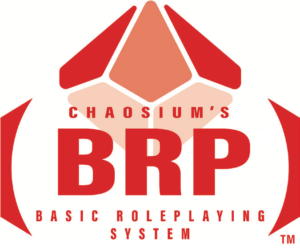This is a roleplaying game, a rule set that allows players to participate in stories of adventure, horror, or action, acting out the parts of the main characters. The game rules provide guidelines for what can and can’t be done, and dice rolls determine whether the characters succeed or fail at what they attempt to do. In roleplaying games, one player takes on the role of the gamemaster (GM), while the other players assume the roles of player characters (PCs). The gamemaster also acts out the roles of characters not guided by players: these are called non-player characters (NPCs).
Roleplaying is a social game, like improvising a story for a play, television show, or movie. Player characters are the primary roles: they are the protagonists the stories revolve around. A player character might be a swaggering gunfighter, depressed private eye, brooding sorcerer, mighty superhero, or a humble spacefarer trying to make ends meet. The gamemaster devises and presents the situations that the players experience, describing the world where they roam and how that world is affected by the player characters’ actions. While each player usually controls only one player character, the gamemaster presents the entire game setting—representing all its people, places, monsters, and even gods.
The gamemaster has a story to present, a collaborative scenario in which the player characters are challenged to interact with non-player characters that the gamemaster personifies. Play is mostly conversation: the gamemaster outlines some situation or encounter and the players dictate what their characters say or attempt to do. Rules provide impartial guidelines for successes and failures of actions attempted. Using the game rules, players announce what their characters do, and roll dice to determine what happens based on their stated intentions. If needed, the gamemaster interprets how the player characters’ actions affect the game world (non-player characters, etc.). The player characters use skills and abilities to face challenges, oppose other characters (player and non-player) characters, and explore the setting the gamemaster has created.
Players create their characters by defining them, with rules that help measure capabilities in quantifiable terms. This information is written down on the character sheet. Information on a character sheet includes terms like strength, intelligence, education, skills, and other abstract elements that make up a person—though ‘personality’ is evoked by how the player character is played by the player. For example, though there is no numerical value for ‘irritable’, the player or gamemaster may speak in such a manner and give that personality to the character. The character sheet is a cross between a résumé and a report card: it defines what they can do, and how good they are at it. Roleplaying is what brings the character to life.
There is a major difference between what the player knows and what the character knows. At the gaming table, players are privy to ‘behind the scenes’ information that their characters don’t have, and they must be careful not to take advantage of this knowledge. Dice rolls are used to determine if a character knows something, even when the player may already know the answer. Similarly, there is no reason a player character’s expertise is limited to things the player knows—a player character can be an expert in fields the player has no idea about.
The purpose of roleplaying is to have a good time. It’s fun to deal with dangers that are not truly dangerous, threats that vanish when everyone rises from the table, and monsters that evaporate when the lights go on. If play goes well, the players feel that they’ve been to an exciting new world for a while, find strength in coping with it, and may even know victory.
- 1.1 Length of Play
- 1.2 Materials Required to Play
- 1.3 Dice and Reading Dice Results
- 1.4 Responsibilities of the Gamemaster

